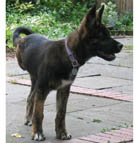How Three-Legged Dogs Help Robo-Design
 Whether you think of them as victims, strong survivors or youtube gold, you probably haven’t thought that three-legged dogs would be useful models for robo-design.
Whether you think of them as victims, strong survivors or youtube gold, you probably haven’t thought that three-legged dogs would be useful models for robo-design.
But a German research scientist, Martin Gross from the University of Jena, has realised he could learn some interesting things about locomotion from how three-legged dogs move. Research on how dogs with three legs learn to run like normal dogs provides interesting robotics findings and could answer the age-old question of how they do it.
Martin Gross first got the idea of studying dogs when staying with his brother-in-law who has four dogs one of which is missing a hind leg. Gross noticed though that less-legged pet was actually faster than the other three.
Robots don’t handle losing legs so well. In a press release, Gross said robots are not meant to operate on an odd number of legs. “Natural terrestrial locomotion is designed for an even number of limbs. After limb loss (e.g. by an injury) a reorganization of the locomotive system is required,” he explained.
So take a leg off a robot and most likely it will just fall over. And lie there. Twitching, until the batteries die. Gross is looking at helping robots recover from injuries, and learn to cope with fewer resources. Resources like legs.
This study is part of the European Union’s Locomorph project to improve robot efficiency and usability, the latest in a string of interesting research projects the EU has commissioned. This project is meant to help develop robots that can adapt in the event of an “injury.”
To explore the movement of the dogs, reflective stickers are placed on parts of them, they are placed on a treadmill and run for a bit in front of a camera. It records how their different legs move. According to the press release, they found that the locomotion of a dog’s front legs don’t seem to change much, if it has lost a hind leg. But dogs that have lost a front limb had to compensate more for motion. A dog carries much of its body weight on its front limbs and those legs are also used for braking, so more compensation is needed. Back legs are used more for propulsion.
[via news.discovery.com]

25 comments
its very terrible picture of dog,i like this blog.
I have a good experience on this site,i have already visit on this site many times,all of pic here is really very nice,I’m very scared when i see this picture,
I can’t believe on this picture.
I have never see this picture before its really amazing picture,thanks for share this.
I think its very informative blog and thanks for sharing this picture.its great……..!
picture is really amazing!I would like to thanks for sharing this wonderer picture.
Amazing picture,I would like to thanks for sharing this.
the whole story of this blog is about a three legs dogs who have three legs.I think whole story is very interesting.
This article it’s great but i don’t like three leg dog
I like this photo but i never see three lag dog and nice blog.
I like this photo but i never see three lag dog and nice blog.
http://www.articlespeak.com/wall-street-journal-subscription-discount-best-deals/
I’m very shock after see this picture,its really very terrible.
the picture is really very amazing!I have never see three legs dog.
The whole blog is really very nice.
I’m seeing Three-Legged Dogs first time in my life.its really very terrible picture.
The movement of three-legged dogs is being studied to help scientists design robots that can adapt in the event of an “injury.”
The movement of three-legged dogs is being studied to help scientists design robots that can adapt in the event of an “injury.”
What i say about designer and the dog also, both are doing really nice work to create robo form design.
I say only word after seen this, awesome design i really like it.
According to me, it’s a magic of designer and the dog stand on land, both are really good.
Aah it’s really a coincidence of nature, and i have seen few times this type coincidence. but when i see this picture on that times That dog how he balance has been created.
Hey i am quite impressed with designer, and it is totally depend on dog how long he stand on three legs.
Wow this is so clever to use nature for good. I’ve seen quite a few three legged dogs and cats so this is a good step forward.
If the dog can balance it out then the designer of the robot can easily imitate such kind of movements.
What an innovative thinking!! I am really impressed.
Comments are closed.